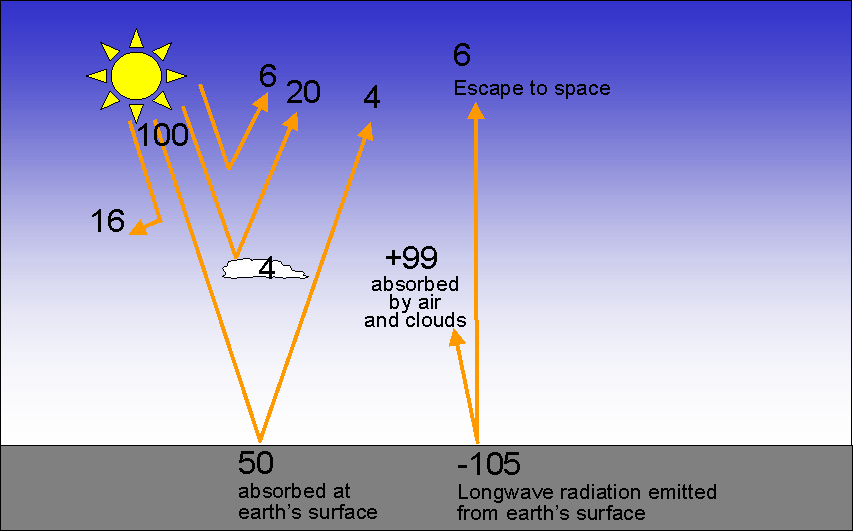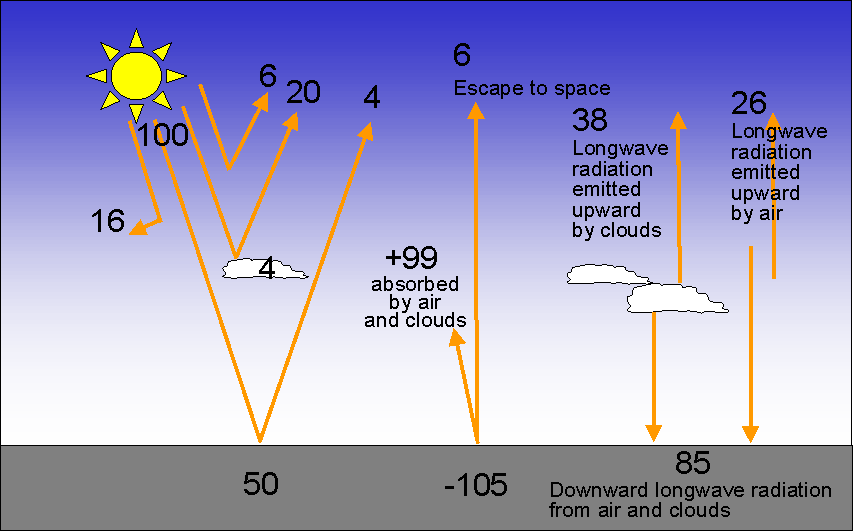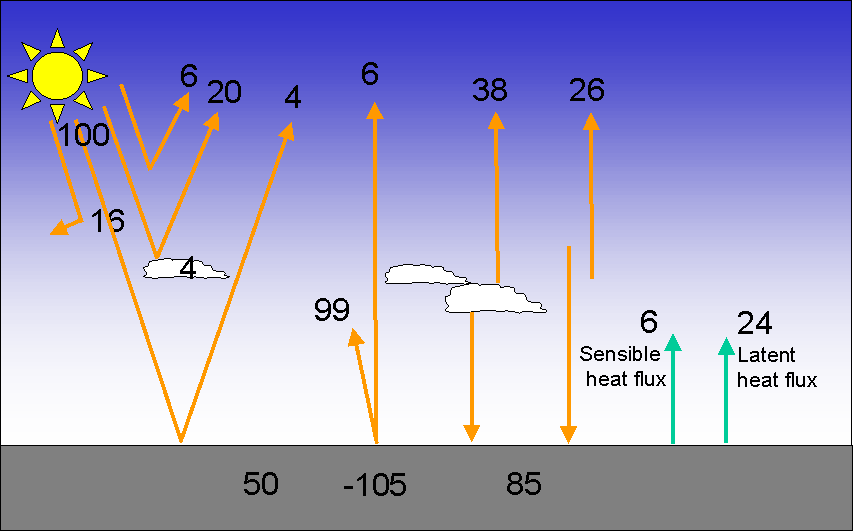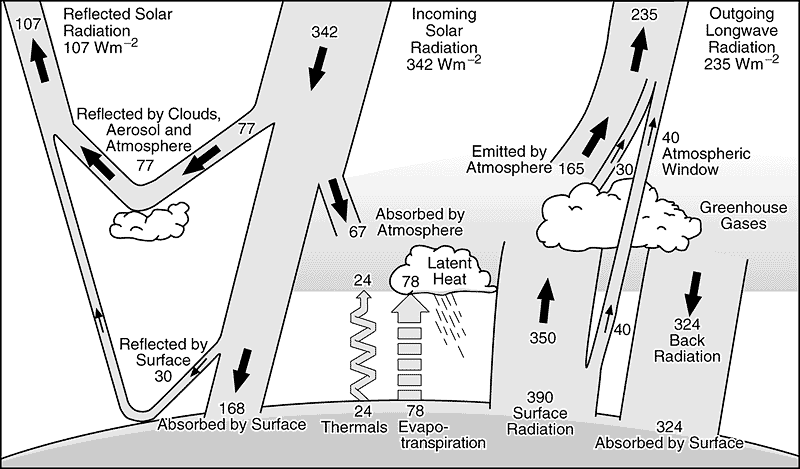![[Home]](../../icons/home.jpg)
![[Lectures]](../../icons/lectures.jpg)
![[Previous]](../../icons/previous.jpg)
![[Next]](../../icons/next.jpg)
The Earth's Energy Budget II -- Radiation Emitted by the Earth, the Greenhouse Effect, and
the Overall Energy Balance
On the previous page we looked at the absorption of solar radiation by the Earth.
This is the energy into the planet Earth. Because the average temperture of the
Earth is nearly constant from year to year, using the principle of energy balance,
we know that the radiation energy emitted by the Earth must equal the radiation energy
absorbed from the Sun. Using the radiation laws, we could compute the average temperature
for the planet Earth, which we called the radiative equilibrium temperature. As mentioned
on the previous page, the radiative equilibrium temperature of the Earth is 0°F. This
is actually the average temperature of the Planet Earth. If there were no atmosphere (and
no change in the amount of solar radiation energy absorbed by the planet), this
would be the average temperature at the Earth's surface.
The Greenhouse Effect
The average temperature of the planet Earth (based on the amount of radiation energy
that the planet emits to space) is quite a bit colder than the average temperature
of the Earth's surface. The reason this is possible is because the atmosphere plays
a large roll in the emission of infrared radiation out to space. In effect, it restricts the
flow of infrared radiation out to space. This is known as the greenhouse effect. A simplified diagram
to help you understand the basics of the greenhouse effect will be drawn in class.
Basics of the greenhouse effect:
- The atmosphere allows the majority of the Sun's radiation (visible radiation) to pass through to the
surface where much of it is absorbed and goes into heating the surface.
- The atmosphere absorbs the majority of radiation emitted from the surface of the
Earth (infrared radiation). This energy is not lost to space, so it does not cool the planet.
- Each type of gas molecule in the atmosphere interacts differently with radiation, however,
in the atmosphere of Earth, it is mainly water vapor and carbon dioxide that determine the
the strength of the greenhouse effect.. These are the most important greenhouse gases.
Keep in mind that water vapor and carbon dioxide are trace gases in the atmosphere of Earth.
- The most abundant gas molecules, nitrogen and oxygen, do not interact much with infrared
radiation.
- Clouds absorb infrared photons very efficiently, and in essense contribute to the
greenhouse effect.
- The infrared radiation energy absorbed by the greenhouse gases heats the atmosphere. The
energy is shared by all gas molecules by conduction, i.e., collisions between the greenhouse
gases and non-greenhouse gases.
- The atmosphere emits infrared radiation in all directions. The part of the radiation that is
emitted downward is absorbed by the Earth's surface further warming it, that is, the Earth's surface
receives radiation energy from both the Sun and the atmosphere, and therefore is warmer than if there
were no atmosphere. Another way to think of it is that not all of the radiation energy emitted by
the surface is lost to space. A good portion of that energy is absorbed by the atmosphere and then
returned to the surface, slowing the overall rate of energy loss from the surface, thus keeping it
warmer.
The part of the radiation that
is emitted upward goes off to space and cools the planet. However, since the gases in the atmosphere
are at a colder temperature than the surface of the Earth, the radiating temperature of the planet
is colder than the surface temperature. The amount of radiation energy that is emitted from the
planet Earth
to space is equal to what you would calculate for an object at a temperature of 0°F.
- Again it is only the greenhouse gases that are capable of emitting infrared radiation.
On Earth, it is mainly water vapor and carbon dioxide. (NOTE: gases that absorb
infrared radiation also emit infrared radiation. However, these are two separate processes.
Once a photon is absorbed, the energy is transferred to the absorbing gas, and the
photon no longer exists. In a separate process, the greenhouse gases emit different infrared
photons.)
- Clouds emit infrared radiation very efficiently, in essense contributing to the
greenhouse effect.
You should understand that the natural greenhouse effect on Earth is not a bad thing. In fact it
is necessary for life as we know it to exist. If there were no greenhouse effect, the temperature
of the Earth's surface would be 0°F, and most water would be frozen. The concern with global
warming is that of an enhanced greenhouse effect whereby the surface temperature of the
Earth will increase above the present value of 59°F. One way this could happen is by increasing
the concentrations of greenhouse gases in the atmosphere. It is a fact that human activities are adding
greenhouse gases to that atmosphere and that their concentrations in the atmosphere are increasing.
Let me try to simplify this:
- The Earth's surface (Land and Oceans) is constantly emitting (or giving off) infrared radiation.
This process acts to cool the surface because energy is being removed from the surface when it
emits radiation.
- The atmosphere (the greenhouse gases) absorbs some of this radiation energy from the surface and
then returns a portion of it back to the Earth's surface when it (greenhouse gases) emits radiation
downward, which gets absorbed by the surface.
- Therefore, the Earth's surface does not cool as rapidly as it would if there were no atmosphere
because a portion of the radiation energy it emits is returned back to the surface.
- Adding more greenhouse gases to the atmosphere makes the atmosphere more opaque to infrared
radiation, i.e., a larger fraction of the radiation energy emitted by the Earth's surface is absorbed
by the atmosphere.
- Since the atmosphere absorbs a larger portion of the radiation energy emitted by the surface,
it follows that it will also return more of this energy back to the surface of the Earth, further
slowing the rate of surface cooling. Or in other words, warming the surface by strengthening
the atmospheric greenhouse effect. We have come to call this effect global warming.
The greenhouse effect also occurs on other planets.
Depending upon the composition of the atmosphere, the greenhouse effect can be quite
strong. For example, lets look at Venus:
The Planet Venus
- Covered by thick clouds, the planet absorbs 22% of the incoming solar radiation energy and
reflects 78% of the incoming solar energy.
- Even though it is closer to the Sun than the Earth, because of the high reflection, it actually
absorbs less radiation energy from the Sun than the Earth does. The average temperature of the planet
Venus (or its radiative equilibrium temperature) is -31°F.
- But because the atmosphere is very dense and largely composed of carbon dioxide, it has a strong
greenhouse effect, and the average temperature of the surface is 860°F.
The details of the greenhouse effect are quite complicated. I may mention a few of these
complications in class, but I will not expect you to understand them on an Exam.
Clouds have a large influence both on solar radiation input and infrared radiation out.
- Clouds absorb and emit infrared radiation like a solid surface, i.e., clouds are
not selective absorbers/emitters of infrared radiation. Cloud bottoms emit a continuous spectrum
of infrared radiation downward and cloud tops emit a continuous spectrum of
infrared radiation upward.
Because of this, clouds contribute
to the greenhouse effect by emitting infrared radiation that warms the surface. This is very
noticeable at night. If all other factors are equal, cloudy nights are warmer than clear nights.
- Clouds reflect much of the Sun's radiation back to space, which keeps the surface of
the Earth cooler. This is very noticeable during the day. If all other factors are equal,
cloudy days are cooler than sunny days.
- Thus, clouds have both strong cooling (mainly by reflecting visible radiation from
the Sun) and strong warming (mainly by contributing to the greenhouse effect) effects on climate.
Therefore, any changes in cloud amount or in the radiation properties of clouds will
result in climate changes for the planet.
NOTE: Due to time constraints, we are not going to cover the material
below here. You will not be tested on the material; it is there if you are interested.
Completing the Energy Budget Diagrams for the Earth
Addition of infrared radiation to the energy budget diagrams for the Earth |
 |
| The Earth's energy budget including all solar fluxes plus
upward longwave radiation from the Earth's surface.
Atmospheric gases (water vapor, carbon dioxide, etc.) and
clouds absorb 99 of the 105 units emitted by the Earth's
surface. Note that for what we've included so far the net flux at the Earth's surface is
negative (50-105 = -55) while the atmosphere shows a large
surplus. |
 |
| Greenhouse gases (water vapor,
carbon dioxide, methane, ozone, CFCs, nitrous
oxides) and clouds emit radiation upward (64 units) to space and
downward (85 units) to warm the Earth's surface. This
behavior is commonly referred as the Greenhouse Effect. The above figure shows all of the radiational
energy exchanges into, out of, and within the Earth-Atmosphere system. For the entire
planet, the radiation energy in equals the radiation energy out, which determines the
radiative equilibrium temperature. However,
note that the
Earth's surface absorbs more radiation energy than it emits, while the atmosphere
emits more radiation energy than it absorbs. Without some other types of energy exchange
between the Earth's surface and the atmosphere, we would expect that the Earth's surface
would be warming (energy in > energy out) and the Earth's atmosphere would be cooling
(energy out > energy in). Transfer of energy from surface to atmosphere through latent heat transfer
balances energy in with energy out, so that both the surface and atmosphere remain at
a nearly constant average temperature.
|
Addition of Energy Transfers via Conduction and Convection between Earth's Surface and Atmosphere |
 |
| The Earth's energy budget including the sensible heat flux, transfered through the
processes of conduction and dry convection, and the latent heat flux , transfered through the
process of moist convection (phase changes of water, i.e., evaporation from
the surface and condensation in clouds) In a
balanced budget, the energy storage is neither increasing or
decreasing, that is:
| Energy Input |
- | Energy
output | = | 0 |
The sum of the inputs equals the sum of the outputs; the
budget balances, and the entire system is neither warming
nor cooling.
|
Summarizing the energy balances:
- The planet Earth is in radiation balance (at least it was before the recent increase in
greenhouse gases). The energy in (absorbed radiation from the Sun = 70 units)
is equal to the energy out (radiation emitted out to space = 70 units).
- The Earth's surface is in balance. Energy in (absorption of solar radiation plus
absorption of radiation from the atmosphere = 135 units) equals
energy out (emission of radiation plus
latent heat flux plus sensible heat flux = 135 units).
- An interesting point here is that the Earth's surface actually receives more radiation energy
from the atmosphere than from the Sun. How is this possible?
- The Earth's atmosphere is in balance. Energy in (absorption of radiation from the surface plus
moist convection plus absorption of solar radiation plus dry convection and conduction = 149 units)
equals energy out (emission of radiation = 149 units).
A nice diagram from another source
 |
| The Earth's annual and global
mean energy balance. Of the incoming solar radiation, 49% (168
Wm-2) is absorbed by the surface. That heat is returned
to the atmosphere as sensible heat, as evapotranspiration (latent
heat) and as thermal infrared radiation. Most of this radiation is
absorbed by the atmosphere, which in turn emits radiation both up
and down. The radiation lost to space comes from cloud tops and
atmospheric regions much colder than the surface. This causes a
greenhouse effect. |
Consequences of the radiation imbalances
If you consider only the radiation terms, the Earth's surface absorbs more radiation energy than
it emits and the atmosphere emits more radiation energy than it absorbs. The radiation imbalances are
made up for by convection and conduction. These radiation imbalances drive the overturning circulations
of the atmosphere, which for the most part is manifested in the formation of clouds and storms.
Another way to look at it is the bottom of the atmosphere (where it touches the surface) is heated by the radiation
imbalance that takes place at the Earth's surface (radiation energy in > radiation energy out),
while higher up, the atmosphere cools by radiation (radiation
energy out > radiation energy in). This generates the instability that sets that stage for rising vertical
motion, cloud formation, and storms.
Radiation imbalances also drive horizontal weather and ocean circulations that transport energy
from the tropics where there
is a surplus of radiation energy (solar radiation absorbed > radiation emitted to space) to the
polar regions where there is a deficit of radiation energy (solar radiation absorbed < radiation emitted
to space). The heat transfer labeled in the figure below is accomplished by atmospheric circulations
(about 60% of the transfer) and ocean currents (about 40% of the transfer). Another way to
to look at it is that atmospheric and oceanic circulations moderate the temperature differences
between the tropics and the polar regions. If these circulations did not occur, the tropics would be much
hotter and the polar regions would be much colder.
![[Home]](../../icons/home.jpg)
![[Lectures]](../../icons/lectures.jpg)
![[Previous]](../../icons/previous.jpg)
![[Next]](../../icons/next.jpg)




